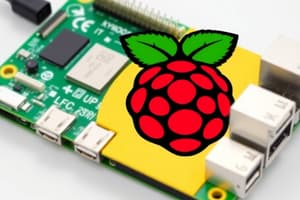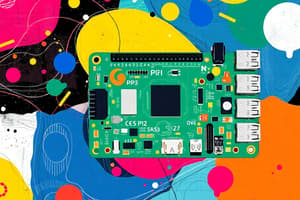Podcast
Questions and Answers
What is the primary focus of The Big Book of Computing Pedagogy?
What is the primary focus of The Big Book of Computing Pedagogy?
- Detailing the history and evolution of computer hardware.
- Providing practical advice on how to program in multiple languages.
- Exploring innovative approaches to teaching computing in the classroom. (correct)
- Introducing advanced hardware configurations for computer systems.
What is the most important element of any teaching?
What is the most important element of any teaching?
- The specific technology that is utilized.
- The context within which that learners are using.
- The programming language that is taught.
- The computing concept that is being taught. (correct)
Concept maps are defined as what type of tool?
Concept maps are defined as what type of tool?
- A diagnostic assessment for student abilities.
- A memory aid for recalling syntax.
- A collaborative coding environment.
- A graphical tool for organizing and representing knowledge. (correct)
In the context of concept maps, what role do cross-links serve?
In the context of concept maps, what role do cross-links serve?
What is the primary purpose of using non-programming activities in computer science education, according to Grover, Jackiw, & Lundh (2019)?
What is the primary purpose of using non-programming activities in computer science education, according to Grover, Jackiw, & Lundh (2019)?
When simplifying concepts for beginning programmers, what crucial element should educators consider?
When simplifying concepts for beginning programmers, what crucial element should educators consider?
What benefit does intentionally allowing learners to "fall into holes and write inefficient code" provide?
What benefit does intentionally allowing learners to "fall into holes and write inefficient code" provide?
The text presents the scenario of shrinking code. What does it say about list comprehensions?
The text presents the scenario of shrinking code. What does it say about list comprehensions?
In the context of learning graphs, which statement best describes the role of nodes?
In the context of learning graphs, which statement best describes the role of nodes?
According to Sweller's research, what are the two key stresses or cognitive loads acting on a learner during a learning episode?
According to Sweller's research, what are the two key stresses or cognitive loads acting on a learner during a learning episode?
In managing intrinsic load, educators should do which of the following?
In managing intrinsic load, educators should do which of the following?
In the context of Cognitive Load Theory, what does the 'split attention effect' describe?
In the context of Cognitive Load Theory, what does the 'split attention effect' describe?
Which of the following is NOT outlined as a stage used in the PRIMM approach to instructional design?
Which of the following is NOT outlined as a stage used in the PRIMM approach to instructional design?
What is a key element of PRIMM that draws sociocultural perspectives on how children learn programming?
What is a key element of PRIMM that draws sociocultural perspectives on how children learn programming?
When encouraging talk in the classroom, what is enabled, according to PRIMM?
When encouraging talk in the classroom, what is enabled, according to PRIMM?
When should a teacher use a learning activity approach such as UDL?
When should a teacher use a learning activity approach such as UDL?
What is correct about the four C's regarding integration into the lesson plan?
What is correct about the four C's regarding integration into the lesson plan?
Which of the following factors is NOT related to the use of ABC in schools?
Which of the following factors is NOT related to the use of ABC in schools?
How can learners' 'knowledge' BEST be used?
How can learners' 'knowledge' BEST be used?
What kind of learning does NOT fit constructionism?
What kind of learning does NOT fit constructionism?
When is using a computer in education most powerful for learning?
When is using a computer in education most powerful for learning?
According to Papert, what must be understood before computers can be used?
According to Papert, what must be understood before computers can be used?
What has the Raspberry Pi Foundation created for implementing pedagogy?
What has the Raspberry Pi Foundation created for implementing pedagogy?
What type of learners are they most likely to include in to their teaching?
What type of learners are they most likely to include in to their teaching?
With UDL teachers are able to think about . . . ?
With UDL teachers are able to think about . . . ?
What way is the teachers to think about that each time they have lesson?
What way is the teachers to think about that each time they have lesson?
What key element should be focused on during the design and implementations of lessons?
What key element should be focused on during the design and implementations of lessons?
Which of the following best describes the role of computing education in the 21st-century learning framework?
Which of the following best describes the role of computing education in the 21st-century learning framework?
How does The Big Book of Computing Pedagogy suggest educators address the tension between research and practice?
How does The Big Book of Computing Pedagogy suggest educators address the tension between research and practice?
What is a primary aim of using glossaries in computing education?
What is a primary aim of using glossaries in computing education?
Why are smaller, carefully selected tasks better when using Cognitive Load Theory?
Why are smaller, carefully selected tasks better when using Cognitive Load Theory?
Flashcards
Concept Map
Concept Map
A visual tool for planning, teaching, learning, and assessment of subject matter.
VELA Concepts
VELA Concepts
Non-programming activities to help students engage with and understand the foundation of programming concepts.
Simplify Concepts
Simplify Concepts
For beginner CS teachers, consider when to simplify a concept or teach the more complex principle.
Learning Graphs
Learning Graphs
Signup and view all the flashcards
Cognitive Load Theory
Cognitive Load Theory
Signup and view all the flashcards
PRIMM Approach
PRIMM Approach
Signup and view all the flashcards
Universal Design for Learning UDL
Universal Design for Learning UDL
Signup and view all the flashcards
Coding & 21st-Century Skills
Coding & 21st-Century Skills
Signup and view all the flashcards
ABC curriculum design
ABC curriculum design
Signup and view all the flashcards
Culturally relevant pedagogy
Culturally relevant pedagogy
Signup and view all the flashcards
Learning through making
Learning through making
Signup and view all the flashcards
Scratch Maths
Scratch Maths
Signup and view all the flashcards
Semantic waves
Semantic waves
Signup and view all the flashcards
Go unplugged
Go unplugged
Signup and view all the flashcards
Crazy characters
Crazy characters
Signup and view all the flashcards
The block model
The block model
Signup and view all the flashcards
The PRIMM Approach
The PRIMM Approach
Signup and view all the flashcards
Concept Maps: Research
Concept Maps: Research
Signup and view all the flashcards
Non-Programming Activities Research
Non-Programming Activities Research
Signup and view all the flashcards
The Code's not all right
The Code's not all right
Signup and view all the flashcards
online video changes teaching
online video changes teaching
Signup and view all the flashcards
Concept Maps: Reseach
Concept Maps: Reseach
Signup and view all the flashcards
Non Programming Research
Non Programming Research
Signup and view all the flashcards
Is The Code Always Right?
Is The Code Always Right?
Signup and view all the flashcards
Learning Graphs
Learning Graphs
Signup and view all the flashcards
Understanding cognitive learning
Understanding cognitive learning
Signup and view all the flashcards
The I in PRIMM
The I in PRIMM
Signup and view all the flashcards
Primarily Pi?
Primarily Pi?
Signup and view all the flashcards
UDL is an inclusive choice
UDL is an inclusive choice
Signup and view all the flashcards
Communicatiing In Code
Communicatiing In Code
Signup and view all the flashcards
Coding and Learning
Coding and Learning
Signup and view all the flashcards
Culture Coding
Culture Coding
Signup and view all the flashcards
All of life is what’s important
All of life is what’s important
Signup and view all the flashcards
Planning 4 Ever
Planning 4 Ever
Signup and view all the flashcards
Remember all the students
Remember all the students
Signup and view all the flashcards
Modelling to Succed
Modelling to Succed
Signup and view all the flashcards
Teach to see
Teach to see
Signup and view all the flashcards
Give to teach
Give to teach
Signup and view all the flashcards
Look outside of yourself
Look outside of yourself
Signup and view all the flashcards
If your heart is in it.
If your heart is in it.
Signup and view all the flashcards
If your Heart is for code
If your Heart is for code
Signup and view all the flashcards
A step up
A step up
Signup and view all the flashcards
Teach People
Teach People
Signup and view all the flashcards
Before Learn
Before Learn
Signup and view all the flashcards
Study Notes
- After nearly five years, Hello World released a special edition, "The Big Book of Computing Pedagogy". This edition focuses on teaching computing in classrooms, including articles and principles.
- The book is structured around twelve pedagogical principles developed by the Raspberry Pi Foundation for England's National Centre for Computing Education.
- Computing education is relatively new and constantly adapting and the Raspberry Pi Foundation launched a Computing Education Research Centre at the University of Cambridge.
- The "Big Book of Computing Pedagogy" aims to guide learning tried and tested teaching approaches and looks to bridge the gap between research and practice.
- The editorial team was led by Gemma Coleman (Editor) and included Louise Richmond and Amy Rutter as subeditors.
- The design was by criticalmedia.co.uk, with Lee Allen as Head of Design and Ty Logan, Sam Ribbits as designers.
- This magazine is printed on paper sourced from sustainable forests and the printer operates an environmental management system which has been assessed as conforming to ISO 14001.
Foreword
- Monica McGill acknowledged training teachers to teach a new subject area (CS) presented challenges for schools and districts.
- The United Kingdom is ahead training teachers to teach CS to all students.
- Computing at School (CAS), The Raspberry Pi foundation have provided training and free resources to teachers.
- This edition provides valuable insights into introducing students computing through unplugged activities and using the PRIMM pedagogical model.
- The first special edition of Hello World is an effort to mitigate those challenges by providing timely, evidence-based resources not just for teachers in the UK, but all around the world.
How to Teach Computing
- The Raspberry Pi Foundation underpins work through twelve principles: leading with concepts, structuring lessons, and making content concrete.
- The plan includes unplugging, unpacking, workng together, reading and exploring code.
- You can foster program comprehension, model everything, and address misconceptions.
- Finally, it includes project creation, hands-on activities, and variety.
Contents
- Topics discussed are the following ones
- Concept maps, which provides a tool for planning, teaching, assessment.
- VELA Concepts refers to activities of teach concepts.
- Learning the right way to simpify, learning graphs for progression.
- Discusses cognitive load theory and structures of lessons, including the PRIMM approach,
- Also explores Universal Design for Coding & 21st-century skills.
- Topics about collaborative problem solving and version.
- Some titles include physical computing get hands on, art and algorithms creativity in programming.
Lead With Concepts
- Concept maps as graphical tools for organizing and representing knowledge, useful for teachers and learners in planning, teaching, and assessment.
- Focus questions, concept lists, and relationship exploration are part of concept map construction.
- Concept maps have a structure that impacts expressive power but requires short propositions from educators.
- Important for lesson planning, enhancing communication between educators and learners, presenting or summarizing information, connecting new and assessing new information.
- Using non-programming activities to teach introductory programming concepts has been shown through research; activities examples include story variables, cat and ladders, etc.
Structure Lessons
- Cognitive load theory is reviewed when determining limits of the working memory, instructional methods to avoid working memory, such as breaking the learning up to smaller tasks and presenting information clearly.
- Intrinsic cognitive loads relate to complexity of subject, and extraneous load regards how materials are presented.
- Load balance is needed in the classroom to manage time, and cognitive and extraneous loads.
- Manage extraneous loads by combining texts and graphics when presenting, presenting information both visually and orally, making sure data is available to all.
- PRIMM is an effective method and the various stages and aspects relating to these.
- Universal Design for Learning in computing helps remove potential barriers in the classroom to make the class more accessible for every student.
- Some focus areas and recommendations are made in that regard, for different teaching frameworks
- Coding to develop thinking for 21st century skills, with four concepts.
- Learn, innovate, and create and communicate
- Finally, the ABC appraoch and various related recommendations to designing and implementing
- Plan to present more of a variety
Studying That Suits You
Use AI to generate personalized quizzes and flashcards to suit your learning preferences.




